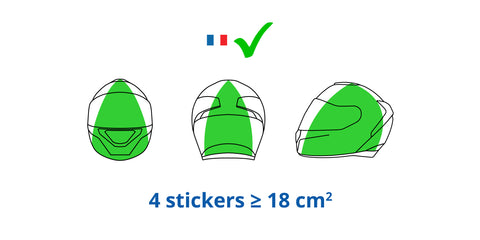MOTORCYCLE HELMET LEGISLATION
Regulations for reflective stickers
Summary of the legislation of stickers for motorcycle helmets :
Mandatory
To be approved in France, a helmet must have the 4 reflective stickers stuck on the areas above.
- Mandatory reflective stickers on motorcycle helmets
In France, helmets must have 4 reflective strips, under penalty of a 4th class fine for non-approved helmet: 135€ and 3 points off your license!
- French regulations in force
- A motorcycle helmet must have 4 reflective stickers, 1 on each side: front (chin strap or forehead), back, right, left (see diagram above)
- The surface area of each element must be at least 18 cm2, and it must be possible to inscribe a circle 4 cm in diameter OR a rectangle 12.50 cm2 and 2 cm wide.
- The stickers must not be torn, bent or affect the operation of the helmet.
- Are the black reflective strips approved?
According to French law, to be approved, helmet stickers must reflect in white: white, like black, reflects in white.
The daytime color is not officially regulated and therefore, the black reflective sticker is not officially approved to date.
This is why there is still a legal uncertainty and why some motorcyclists prefer to use white stickers to avoid taking risks.
Numerous sources, including police officers, have told us that black reflective stickers on helmets are not fined, it is the absence of the stickers that is fined (-3 points on your license and 135€ fine).
The power of retro reflection is the most important element (Our 3M Technology™ products are the most effective on the market). In addition, the size, geometry and the correct position of the 4 elements of the helmet, as seen above, are controlled.
- Examples of compliant stickers
You need a surface of 18cm² minimum and insert a circle of Ø 4cm or a rectangle of 12.5cm².

With the BLACK STANDARD™ stickers we can make, for example, a square of 4.3 cm sides. That is: (4.3 x 4.3 = 18.4 cm²)

Inserting circles or rectangles
It must be possible to inscribe in each element of 18,4 cm2 : a circle of Ø 4 cm OR one rectangle of 12,50 cm² of fully reflective surface.
Attention, the rectangle must be at least 2cm wide !
- What are the other approvals for motorcycle helmets?
- General approval
In traffic, the motorcyclist must wear an approved helmet properly attached (Article R431-1 of the Highway Code).
Whatever helmet is used, it must comply with ECE-22-04/ ECE-22-05/ ECE-22-06 standards.
In June 2020, a new standard (ECE 22-06) was voted for this approval of motorcycle helmets. It implies a more severe test protocol (linear and oblique impact tests, more precise measurement of the resistance to the shocks caused to the brain, resistance to abrasion...).
Brands that do not comply with this approval will not be able to sell their helmets from June 2023.
2. How to prove it?A helmet is considered approved when it has a white label with the European standard ECE 22-04, ECE 22-05 or ECE 22-06.
On this label we find :
- An E followed by a number indicating the country of origin of the approval (2 corresponds to France)
- There are then 6 digits beginning with either 04, 05 or 06, representing the amendment number of regulation number 22. France refuses the amendment 03 of this same regulation (orange label)
- Thereafter, we find one or more letters J(Jet helmet), P(minimum jaw protection), NP(does not protect against chin impact) or JP(double approval Jet and Integral)
- The production serial number is indicated by the last numbers.
There is no official indication of the level of protection of the helmets, however there is the SHARP test which gives a 5 star rating.
- The laws
Motorcycle helmets must be fitted with retro-reflective elements in compliance withArticle 6.16 "Signage".
You can also find other regulations relating to motorcycle helmets in the full legal text EE/ECE/334.










